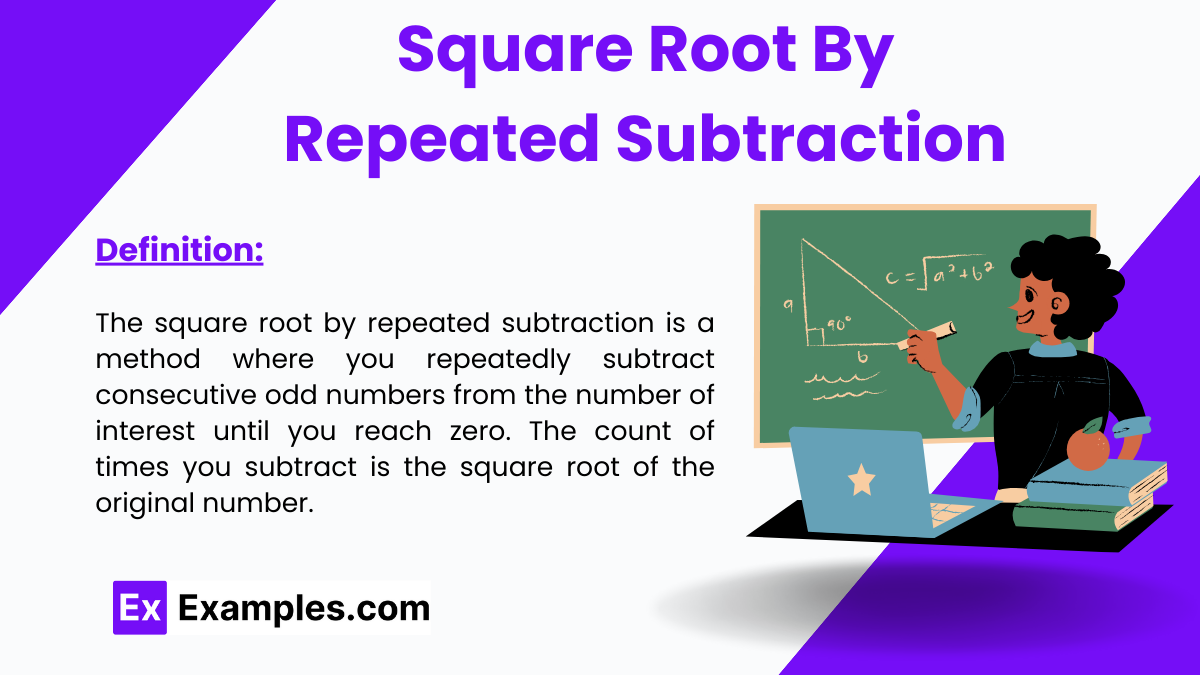What is the square root of 16 using repeated subtraction?
2
4
6
8


The square root by repeated subtraction method is a foundational mathematical technique used to determine the square and square root of a number by sequentially subtracting consecutive odd integers. This approach not only introduces students to basic concepts in algebra and arithmetic but also links to more advanced topics such as rational and irrational numbers, emphasizing their practical applications in fields like statistics. By understanding how integers and their properties interact within this method, learners can better grasp concepts like the least squares method, which is pivotal in statistical analysis and data fitting. This method serves as an engaging gateway to exploring the broader implications of square and square roots across various mathematical disciplines.
Let’s calculate the square root of 16 using this method:
The method of finding a square root through repeated subtraction is a straightforward yet educational technique used in mathematics, particularly beneficial for grasping the concept of square roots from a fundamental level. It involves subtracting consecutive odd numbers from the given number until the remainder is zero. This method is most effective with perfect square numbers and serves as a hands-on learning tool in understanding how numbers are composed.
Identify the number from which you want to find the square root. Ensure that it is a perfect square to apply this method effectively.
Begin subtracting consecutive odd numbers starting from 1. After subtracting each odd number, subtract the next higher odd number from the result:
Keep a count of how many times you subtract until the remainder equals zero. The process of subtraction should continue until no remainder is left.
The count of total subtractions you have made gives you the square root of the original number.
The number of subtractions was 7, which means the square root of 49 is 7.
This method is particularly useful in educational settings, helping students visualize and understand the process of finding square roots without the need for calculators. While it specifically applies to perfect squares, exploring this technique can also lead to discussions about rational and irrational numbers, algebraic principles, and integer properties. Moreover, the method fosters a foundational understanding that connects to more complex mathematical theories and statistical methodologies, such as the least squares method used in data fitting and prediction.
Find the square root of 25 using the repeated subtraction method.
Number of subtractions: 5, which is the square root of 25.
Calculate the square root of 36 using repeated subtraction.
Number of subtractions: 6, which is the square root of 36.
To perform the square root by repeated subtraction, start with your target number and subtract consecutive odd numbers beginning with 1, then 3, 5, 7, and so on, until you reach zero. The total number of times you subtract is the square root of the original number.
This method is only applicable to perfect squares. If the number is not a perfect square, the process will not end with a remainder of zero, and you will not get a whole number as a square root.
The main limitation of this method is that it only works accurately for perfect squares. Additionally, it can be time-consuming and impractical for very large numbers. For non-perfect squares, the method will not yield a precise square root.
Text prompt
Add Tone
10 Examples of Public speaking
20 Examples of Gas lighting
What is the square root of 16 using repeated subtraction?
2
4
6
8
Find the square root of 25 using repeated subtraction.
4
5
6
7
Determine the square root of 36 using repeated subtraction.
5
6
7
8
What is the square root of 49 using repeated subtraction?
6
7
8
9
Find the square root of 64 using repeated subtraction.
7
8
9
10
Determine the square root of 81 using repeated subtraction.
9
10
11
12
What is the square root of 100 using repeated subtraction?
8
9
10
11
Determine the square root of 144 using repeated subtraction.
10
11
12
13
Find the square root of 196 using repeated subtraction.
11
12
13
14
Determine the square root of 225 using repeated subtraction.
14
15
16
17
Before you leave, take our quick quiz to enhance your learning!

